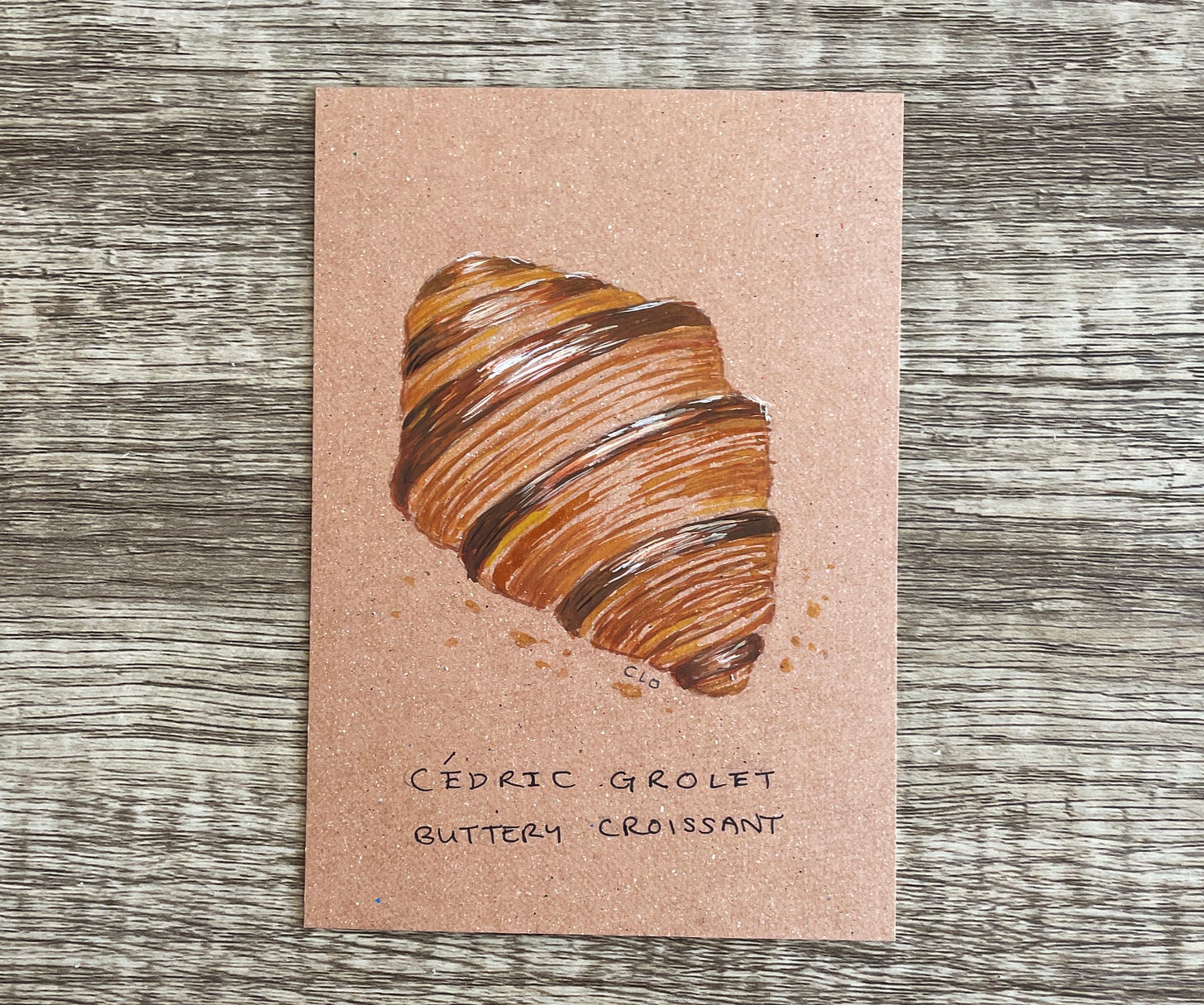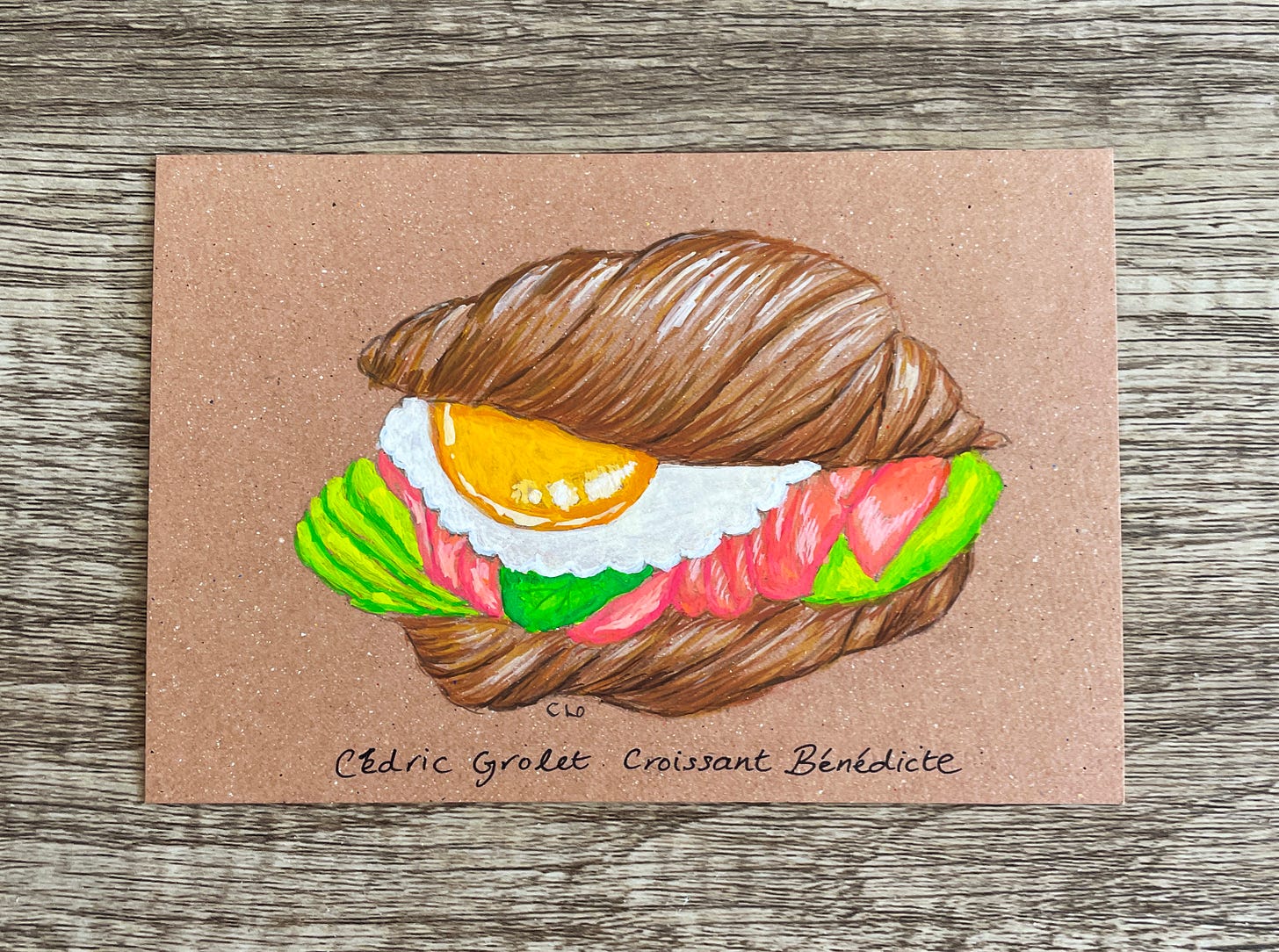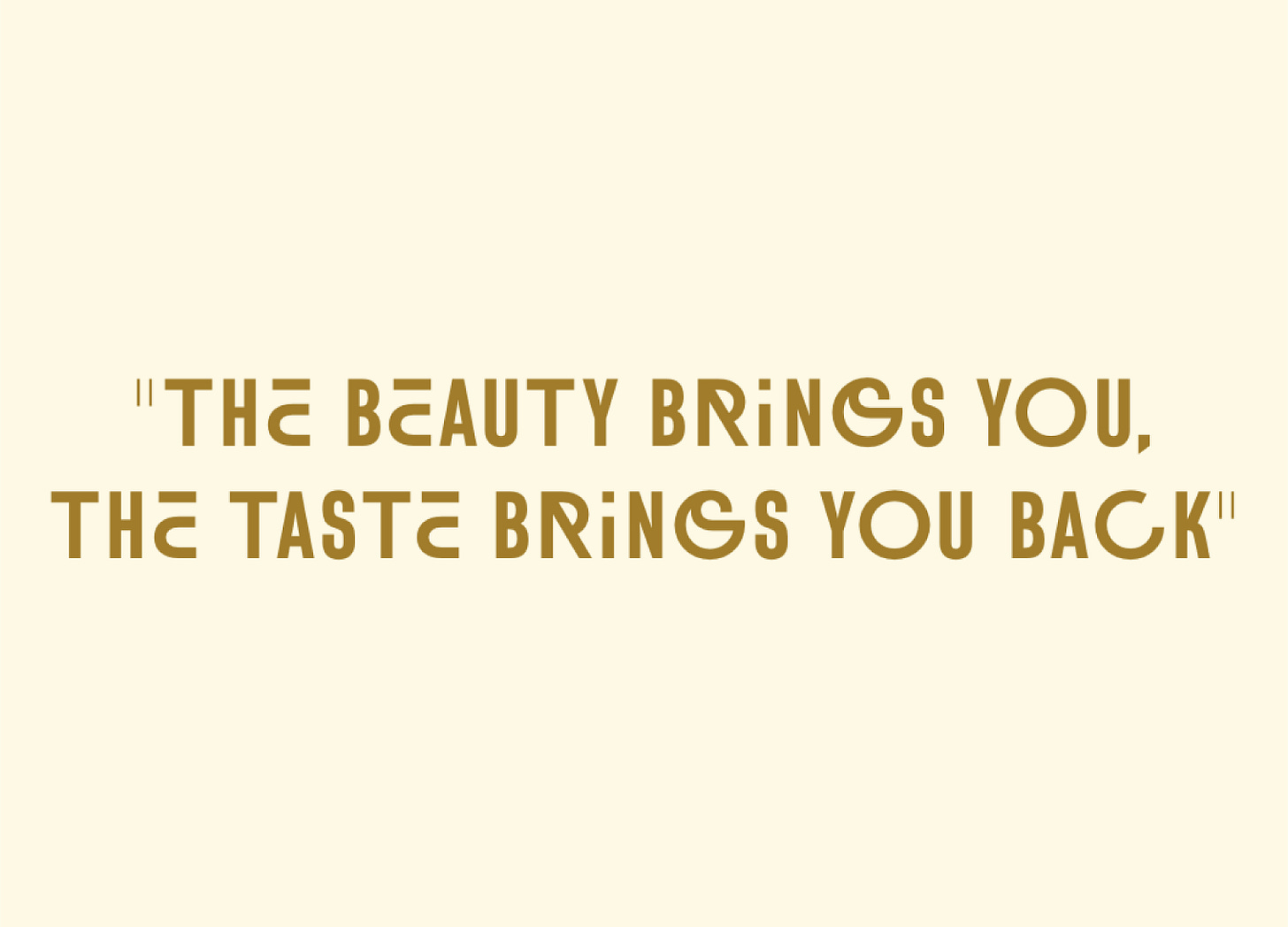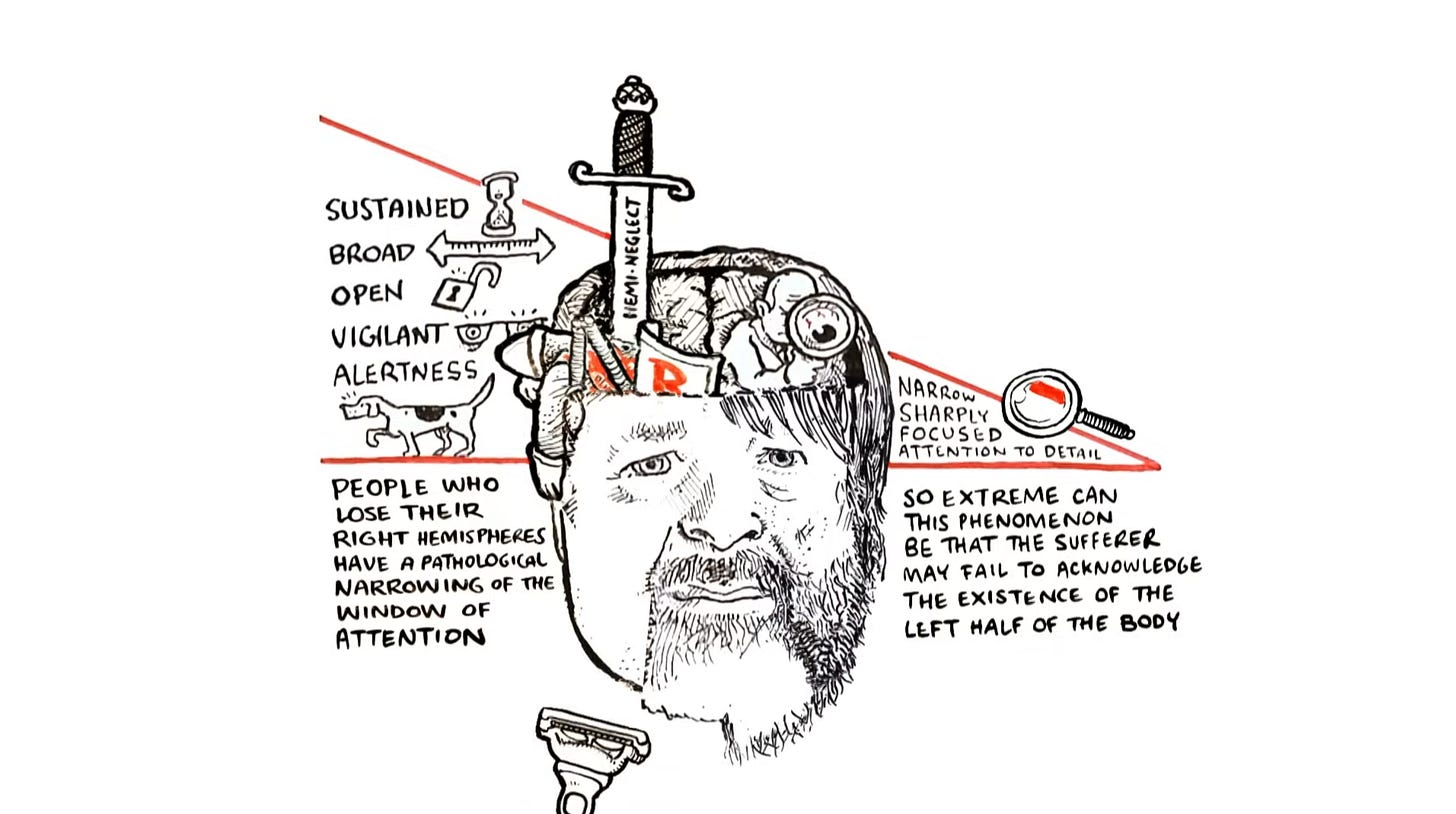Hand painted illustration of the classic buttery Cédric Grolet croissant by yours truly. An experience so good that eating it wasn’t enough – it had to be immortalised on paper.
Customer Experience (CX) is the entire experience and relationship a customer has with a brand. Most companies think this is about tracking customers through business metrics – chasing NPS scores (Net Promoter Score – those surveys asking how likely you’d recommend a company to someone you know based on your experience), conversion and churn.
However, this approach completely misses out on the IRL quality of the customer’s experience.
It’s painfully boring for customers to have experiences that feel functionally efficient, yet totally lack sensorial pleasure – the vital ingredient that creates desire, emotional connection and keep them coming back for more.
Well, recently I had an out of this world experience with a croissant (ok, two) that completely changed how I see CX forever. Here’s what you can learn from a €7 croissant, and why it taught me more about Customer Experience than anything I’ve read.
Meet Cédric Grolet – the world’s best pastry chef.
A genius Frenchman with 12.8 million followers on Instagram, who went viral for his hyper realistic, Dali-esque trompe l’œil pastries that look like real fruit until you bite into them. The same chef whose daily hours-long queues are likely longer than Labubu’s.
But it’s not his famous sweet stuff that captivates me.
It’s actually his croissant, the plainest and most humble of his creations.
Which also happens to be an iconic symbol of French pastries.
Because what he’s done isn’t just pastry perfection, he’s also transformed the way people perceive pastries as everyday baked goods, and has elevated their experience to unparalleled heights of deliciousness.
But what can we actually learn from a croissant?
Here are a few things out of Cédric’s secrets that can elevate your CX to the next level.
Create magic by unlocking the senses
His croissant is an embodiment of perfection, craftsmanship and meaningful innovation of a centuries-old tradition, which is no small feat.
Sight
Photo of Cédric’s croissants at Cédric Grolet Opéra in Paris by yours truly
The attention to detail of a Cédric croissant is unrivalled, as is its generous size and mathematical uniformity.
The secret to a good one, which is notoriously hard to create (let alone improve), is in its many precise folds. But Cédric’s version goes a step further, pioneering his own unique design signature in the form of gorgeous glossy ribbons wrapping the croissant like a gift.
It is distinctively recognisable from afar, often imitated but never replaced. It is the visual shorthand to his creativity, craftsmanship and quality. Even without the logo, you can tell it’s uniquely Cédric.
Photos of Cédric Grolet Opéra Paris by yours truly
Along with the distinctive, hyper-premium design language of his branding, museum-like pastry displays, specially designed tableware and beautiful interiors with the design reverence of an Aesop store (not to mention the magical loos that are seriously worth visiting where even nature’s call is fun – trust me on this one), the whole experience is about creating pleasure for the senses.
A refined yet relaxed atmosphere with elegance everywhere you look, and ample space to get cocooned in your own ambrosial enjoyment.
Just think about the difference between walking into an Apple store compared to a Costco.
Smell
The quality of ingredients, particularly the butter (pas de surprise), is exquisite. The unique scent of Cédric’s baking when you walk past his stores is also vastly different to how other bakeries or patisseries smell.
In everyday terms, anyone who’s able to tell a fast food chain simply by its smell will know what I mean (guilty as charged).
It’s proof that even seemingly elusive senses like smell can become experience signatures that are unique to a brand’s DNA. Sensorial brands like Stella McCartney, Le Labo and Heston Blumenthal all know the power of smell to connect to memory and emotion.
As opposed to the overly saccharine smell at Starbucks, or trains with that musty smell of dirtiness and despair.
Sound
Remember that scene in Pixar’s Ratatouille where the secret to a great croissant is in its sound? A crispy symphony can tell you how fresh a croissant is, as well its cloud-like airiness when made properly.
The Cédric croissant is the real-life version of that symphony, no exaggeration.
Onomatopoeia and sound design can be extremely evocative experience signatures, and gives a sense of what the experience is like before trying it – think of the popularity of ASMR in melting away stress, or Rice Krispies’ iconic Snap, Crackle Pop – so catchy it even became its tagline.
You can just tell when sound is considered as part of the experience, because it’s painfully irritating when it’s not.
Just think of those restaurants with cutting edge industrial interiors that look amazing, but make you struggle to have a conversation with the person mere centimeters across you, because no one thought about soundproofing to shield other conversations, neutralising glasses clanging, or drowning out noisy chairs.
Or worse, a playlist that’s totally out of sync with the chef’s brand and menu concept.
Sound, whilst being invisible, can have a profound effect on the eating experience (or completely kill the ambience).
Taste
Not only can you taste the flaky, buttery perfection in terms of flavour and luxurious mouthfeel – which is a complete joy in itself – it’s also satisfyingly filling, unlike other more anaemic croissants. You can literally taste the amount of care and craft that’s gone into making it. Not to mention the quality ingredients that create its superior taste.
If that’s not enough, wait till you try the Croissant Bénédicte.
Hand painted illustration of Cédric Grolet’s Croissant Bénédicte, also by yours truly.
This is the dressed up version of the Cédric croissant that’s a delicious meal in itself.
Not only do you get the aforementioned generous croissant of perfection, it’s now amplified with the very best version of Bénédicte ingredients that together taste far fresher and better than the sum of their constituent parts. Every element tastes like the best version of itself, and they work together in blissful harmony.
Even the egg comes with scalloped edges, like handcrafted couture. I have no idea how this magic is possible, other than each bite genuinely makes me feel more alive and present.
It’s the difference between that plasticky flavour of I Can’t Believe It’s Not Butter and the delicious creaminess of an AOP butter (Appellation d’Origine Protégée) from grass fed cows (and the French know their butter better than anyone else).
To quote Sainsbury’s, you can Taste The Difference.
Touch
The croissant feels thicker than most in its weight and quality – just try pulling one apart. It’s the same premiumness you get from the weight of the new Louis Vuitton beauty compacts by the legendary Pat McGrath, or the satisfying soft thump of a Jaguar door being reassuringly shut. It’s why eating food from proper porcelain plates feels vastly different to eating from plastic ones. You just know it’s quality simply by touching it.
But the pièce de résistance has to be the moment it is served.
Not only is it gorgeously plated on its own bespoke commissioned plate, the biggest surprise is when the waiter suddenly pours a mysterious golden sauce that can only be described as liquid sunshine onto the croissant – elevating a breakfast pastry to haute cuisine.
It’s suddenly gone from being a two-hand job to a proper knife and fork experience.
Video clip by yours truly of the magical pouring of their proprietary golden elixir of “œuf beuré” (buttered egg) onto the savoury Croissante Bénédicte.
The act of this sacred pouring is the equivalent of an artist’s Midas touch to their masterpiece, or the final flourish of a chef just before announcing “Service!” and bringing it to the customer.
And it feels visceral because you are literally experiencing this luxuriation in front of you in full technicolour, multisensorial slow motion.
Feel
Feeling here is three-fold.
First, it’s the feeling you get once you’ve bitten into the croissant, and all your physical senses from the sensations mentioned above are fully engaged for maximum pleasure. When everything is combined in this moment, there’s an intense internal, introspective, in-the-moment experience of pleasure to feel fully satiated and fulfilled.
Second, it’s the emotional feeling of being truly taken care of as a customer as their effortless service is tailored to your needs – before, during and after your eating experience. This is the special moment where the experience becomes interpersonal.
Finally, and most importantly, it’s how you feel about the brand you’ve just experienced. How they make you feel in their effort to build a relationship with you. Your emotional connection and trust in the brand makes you choose this brand above others, every single time.
Crucially, this is what builds brand equity and customer value in the long term.
By combining these three strands, sensations and emotion are woven together, etching the experience into the customer’s brain forever. This is especially powerful when it’s a unique one.
As Cédric himself rightly sums up, “The beauty brings you, the taste brings you back.”
Cédric Grolet’s menu.
The undeniable truth is that we feel more alive, our experiences more real and delicious,
when we connect to all of our senses, and when we truly value human connection.
A holistic, whole-brained approach to experience
Yes, Cédric Grolet has seamless online booking experiences, the usual attentive comms to check your dietary requirements, a special queue for reserved bookings and QR codes to order. But these are literally hygiene table stakes (excuse the pun) that any brand can create. These are not the experiences that make Cédric Grolet special or memorable.
If we are to create experiences that create desire and self actualisation for brands and people, we need to be more holistic in our approach.
‘The Divided Brain’ video by Iain McGilchrist via RSA, Youtube (highly recommended).
When we look at CX today, it’s typically driven by hard measurements – NPS, conversion, sales, churn, CLV (Customer Lifetime Value).
There’s nothing wrong with having tangible measures of success, but a survey or stat just doesn’t do justice to the customers or actual experience itself – it has no colour, meaning or emotion.
According to psychiatrist Iain McGilchrist, when we only pursue left brain priorities (“The Berlusconi of the brain”) with machines, control and reason, “we get perfection but it is empty.” The equivalent of AI with no soul or originality. Without the right brain of creativity, emotions and richness of real lived experiences, what we’ve done is:
“We have created a society that honours the servant, but has forgotten the gift.”
Metrics try to represent the customer en masse, without fully valuing how they really feel, nor are they able to articulate what makes a brand and its experiences unique.
The irony is not lost on me that we are using left brain measures to define CX when we are dealing with fundamentally real-life, human, sensorial, emotional, right brain experiences.
We need both.
And this, I believe, is one of the most telling gaps between CX that’s driven by profit and efficiencies above all else, versus desirable experiences that bring brands and people together:
The distinctiveness, desirability and cultural cachet of a unique brand.
The colour, flavour and texture of the discovery and deliciousness of the eating experience.
The emotions of how customers really feel biting into their first croissant of perfection.
The memories that evoke joy and the desire to come back again and again.
The effort to build a meaningful relationship with you as an important customer.
These are the things that elevate CX to new heights.
The things that build emotional connection with brands and long term growth.
What This Really Means
When it comes to elevating your CX, it’s important to get back to first principles beyond the logistics.
Get clear about what makes your brand unique.
Choose the senses of the experience that really make it sing.
Create deep, visceral connections with your customers by evoking their emotions and desire.
And earn the trust and relationship that makes them choose you above all others.
The CX 6-senses audit tool
Here’s a helpful tool I use with clients to elevate their sensorial deliciousness across their CX.
Take an honest look at your brand across these 6 senses, and rate it from 1 to 10 (1 being non-existent (or worse, unpleasant), 10 being excellent).
Anything below a 7 is a missed opportunity to build emotional connection with your customers through the senses, as most brands only focus on 1 or 2 senses at best.
Because according to Harvard Business Review and Binet and Field, the more emotionally engaged your customers are with your brand, the higher their value and long-term loyalty.
Remember Cédric’s buttery liquid sunshine sauce? Find your golden sauce moment. What is the one detail for one of the senses that will make your experience unforgettable for your customers and can’t get enough of?
Sight
• What’s the first thing customers see when they encounter your brand?
Is it unique to your brand?
• Do you have any distinctive design signatures?
Can you tell if it’s your brand if you removed the logo (like Cédric’s ribbon croissants)?
• Does your physical/digital space look premium or cheap?
Does your space improve your customers’ perception of your brand’s value?
• How is colour and texture being used across your experiences?
Does the experience look enticing or wallpapered (matching luggage with no meaning)?
Sound
• What does your brand “sound” like? (Think Rice Krispies’ snap-crackle-pop)
• Do your products make satisfying sounds when used?
Are there unpleasant sounds/noises that need to be nixed?
• What’s the audio experience in your spaces? (Music, ambient noise, product sounds)
• Does your brand voice have a consistent “sonic signature”?
Can customers recognise your brand through your sound/jingle?
Smell
• Can people identify your brand by scent alone? (Like McDonald’s or Subway)
Are there any unpleasant smells that need to be addressed?
• What does your physical space smell like?
• Are you missing opportunities to create scent memories?
• Could smell enhance your product experience?
Touch
• How does your product feel in customers’ hands?
• Does the weight/texture communicate quality? (iPhone heft, luxury car doors)
• Do your materials reflect the desired value of your brand?
• What’s the tactile experience of opening and using your product/service?
Taste
• For non-food brands: What’s the “flavour” of your experience? Is it distinctive?
• Does every interaction leave a good “taste” in customers’ mouths?
• Are you delivering on your promise, or does reality taste bland?
• What’s the lasting impression after the experience ends?
Feel
• Are all the 5 physical senses being used to engage customers?
Which one(s) have you missed?
• Is there a missed opportunity to make customers feel more loved or understood?
• How do your customers really feel emotionally about your experience beyond NPS scores? Why?
• What are you doing to build a meaningful relationship with your customers beyond the first interaction/sale?
Which of the 6 senses is your brand ignoring? What is your biggest CX blind spot?
Leave a comment below.
Interested in creating sensorial experiences that customers can’t get enough of?
Book a call with me to unlock your brand’s deliciousness.







